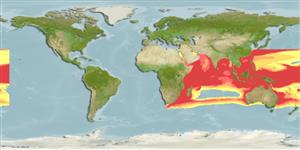Common names from other countries
>
Eupercaria/misc (Various families in series Eupercaria) >
Monodactylidae (Moonyfishes or fingerfishes)
Etymology: Monodactylus: Greek, monos = one + Greek, daktylos = finger (Ref. 45335).
More on author: Linnaeus.
Environment: milieu / climate zone / depth range / distribution range
นิเวศวิทยา
เกี่ยวกับทะเล,น้ำเค็ม; น้ำจืด; กร่อย; ระดับความลึก 0 - 12 m (Ref. 86942). Tropical; 24°C - 28°C (Ref. 1672); 31°N - 42°S, 19°E - 169°W
Indo-West Pacific: Red Sea and east coast of Africa south to the Breë River (Ref. 7293, 52193); also the Persian Gulf (Ref. 96822) to Samoa, north to the Yaeyamas, south to New Caledonia and Australia (Ref. 4959). Known from the freshwater tidal zone of the Mekong delta (Ref. 12693).
Length at first maturity / ขนาด / น้ำหนัก / Age
Maturity: Lm 13.0 range ? - ? cm
Max length : 27.0 cm SL เพศผู้/กระเทย; (Ref. 44894); common length : 12.0 cm TL เพศผู้/กระเทย; (Ref. 5450)
เงี่ยงครีบหลัง (รวม) : 7 - 8; ก้านครีบอ่อนที่หาง (รวม) : 27 - 31; เงี่ยงครีบก้น: 3; ก้านครีบอ่อนที่ก้น: 27 - 32.
Found in bays, mangrove estuaries, tidal creeks, and lower reaches of freshwater streams (Ref. 2847, 44894, 48636); occasionally in silty coastal reefs (Ref. 9710). It feeds on plankton and detritus (Ref. 5213, 44894). Commonly seen in large schools (Ref. 44894, 52193); small juveniles either solitary or in small aggregations (Ref. 48635). Usually only juveniles enter freshwater (Ref. 52193). Highly territorial (Ref. 9710). Caught with throw nets (Ref. 30573).
Life cycle and mating behavior
Maturities | การสืบพันธุ์ | Spawnings | Egg(s) | Fecundities | ตัวอ่อน
Heemstra, P.C., 1984. Monodactylidae. In W. Fischer and G. Bianchi (eds.) FAO species identification sheets for fishery purposes. Western Indian Ocean (Fishing Area 51). Vol. 3. FAO, Rome. [pag. var.]. (Ref. 7293)
IUCN Red List Status (Ref. 130435)
CITES (Ref. 128078)
Not Evaluated
Threat to humans
Harmless
Human uses
การประมง: มีการค้าเพียงเล็กน้อย; สถานที่แสดงสัตว์และพืชน้ำ: การค้า
เครื่องมือ
Special reports
Download XML
แหล่งที่มาจากอินเตอร์เน็ต
Estimates based on models
Preferred temperature (Ref.
115969): 22.9 - 28.8, mean 27.6 (based on 638 cells).
Phylogenetic diversity index (Ref.
82804): PD
50 = 0.5781 [Uniqueness, from 0.5 = low to 2.0 = high].
Bayesian length-weight: a=0.02951 (0.01733 - 0.05027), b=2.98 (2.83 - 3.13), in cm Total Length, based on LWR estimates for this species & (Sub)family-body (Ref.
93245).
ระดับชั้นอาหาร (Ref.
69278): 3.1 ±0.26 se; based on food items.
Fishing Vulnerability (Ref.
59153): Low vulnerability (23 of 100).
